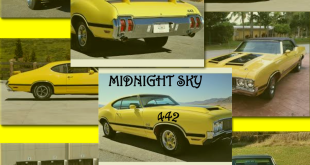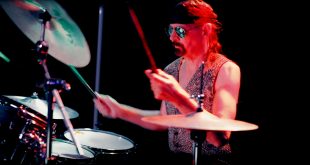This dynamic duo is back at it again for The Mirage Project, Season 2. They are joined by London-based DJ Jonny Miller to help them map out the farthest reaches of the Mirage cosmos – and the human imagination. The next chapter to be released is “Mirage VI: Kronos,” destined to take viewers on a journey to an all-encompassing timekeeper harmonizing an intricate dance of cosmic events.
The elegant techno-dub soundtrack for “Kronos” was created by New York-based sonic wizard Brendon Moeller exclusively for Sonarpilot Audio. “Kronos” unveils long, sinuous melodic motifs; as the composition unfurls its wings, the track embarks on a kaleidoscopic transformation. Like shards of a sonic prism, the musical elements scatter and converge, leaving behind impressions of fleeting beauty and the evanescence of time.
Like the inside of a watch or clock, the “Kronos” music video opens to a set of gears turning in sync with one another. It all seems normal at first, but then things get weird: another set of differently-colored gears appears on screen, and soon enough, they’re growing, bending, and melting in ways we wouldn’t expect. The weirdness continues, and the gears begin to shift into different sizes, shapes, and colors – fractal versions of themselves, soon becoming unrecognizable from their beginning form. Sonarpilot says about the video, “This enigmatic device creates time, sculpting and flexing its very nature, molding its velocity, orchestrating its myriad of layers. Although the journey takes us close to its source, the tantalizing grip on time’s essence remains ephemeral, slipping through our fingers as we endeavor to capture its essence.”
How do you want listeners to feel after hearing “Kronos”?
Carl Sagan, the renowned astronomer and astrophysicist, once beautifully said, “Imagination will often carry us to worlds that never were, but without it, we can go nowhere.” In my work, I invite my audience to explore these imaginative realms, to momentarily pause, immerse themselves in wonder, and step beyond their daily routines, even if just for a fleeting moment.
“Kronos” serves as a meditation on time and its ever-changing, ephemeral nature. We all understand time, but describing it precisely is challenging; it slips through our grasp like sand. Contemplating this concept is essential; it encourages us to value the time we have and not let it go to waste.
Where do you get your inspiration from?
My inspiration draws from three primary sources. Firstly, there’s the world of music, as is the case for most musicians. Then, there’s the visual art scene—I frequently visit museums, exhibitions, and stay updated on digital art trends, seeking interesting ideas and fresh perspectives for my work.
The third source of inspiration delves into those profound existential questions we all ponder: Who are we? Where do we come from? What is the nature of the cosmos, reality, and our consciousness? To explore these mysteries, I engage with documentaries, read books, and maintain a curated podcast playlist filled with insights on these enigmatic subjects.
Yet, inspiration remains somewhat elusive; it’s a force of its own out there. I feel fortunate that when I’m working in my studio, inspiration naturally gravitates toward me. The heart of my creative inspiration resides within the very process of creation itself.
What is the creative process like?
Since 2020, I’ve been crafting a series of audiovisual journeys that transport my audience into a strange parallel universe I continually expand. Sonarpilot, my artistic alter ego, serves as the intrepid pilot navigating these uncharted territories—a fusion of Major Tom and Captain Picard, slightly untethered but driven by a mission to uncover new, unseen worlds.
I’ve named this endeavor The Mirage Project, with the hope that these journeys provide our audience with a brief respite from their daily routines—a chance to glimpse into otherworldly realms, akin to the imagination Carl Sagan spoke of.
The Mirages are quite labor-intensive. Typically, I create both the visuals and the soundtrack, going back and forth between the two until I’m satisfied. This process takes up to two months.
How do you create graphics that harmonize with the music?
I work closely with a dear friend of mine, Roger Mader, to generate the visuals for my videos. At the start of each production, we discuss the basic visual language we intend to use. All Mirages, as we call our videos, are based on fractals—machine-generated visuals rooted in mathematical formulas. Fractals are a fundamental concept found everywhere in nature, from spiral galaxies to meandering rivers and even the most intricate produce at your local supermarket.
Roger inputs these formulas into a cluster of laptops. After a few days, we sift through the generated samples, selecting the material that aligns with our creative vision. Then, it’s crunch time. The machines start the rendering process. One image might require 20 minutes or more to complete. We need 25 pictures per second of video. So, five minutes of animated fractals might take a week, or even a month, of non-stop rendering time.
Once the basic animations are complete, I commence the editing process. Initially, I’m unsure about the final outcome. I craft collages from the animations, twisting and tweaking them until a new world begins to take shape. This phase demands patience; my aim isn’t just to showcase pretty pictures or impressive special effects. It’s important to me to provide the entire experience with context, a visual flow, and a narrative frame that invites the audience on a specific journey.
During this process, I’m also developing the soundtrack. I start with a rough draft fairly early on. As the Mirage evolves, I continuously refine and adjust it, ensuring the visuals and the sound optimally complement each other, creating an immersive experience.
Which composition posed the greatest challenge?
It’s a tough call. Each track, each production, embarks on a unique journey. However, they all share a common challenge.
You see, I’m quite fortunate as I never grapple with writer’s block. I can always head to the studio and start a fresh track. Ideas flow rapidly, and soon, I’ve amassed a trove of material.
The real challenge for me lies in the realm of decision-making—choosing which elements to incorporate and orchestrating the flow of the arrangement. I tend to get lost in the minutiae, details that may ultimately go unnoticed by the listener. Stripping away the excess and crafting a robust arrangement is consistently the most formidable aspect of composing a track.
Who are your musical influences?
My musical influences encompass a wide spectrum, ranging from 11th-century church music to contemporary leftfield electronica. I have an inclination towards music that veers off the beaten path, music that defies the conventional formula of a pop song, although I’m an absolute sucker for a flawlessly crafted three-minute track with an unforgettable refrain.
In addition to this ever-changing assortment of tunes, I have a set of musical heroes to whom I continually return. Figures like Bach, Miles Davis, the Beatles, and Brian Eno—artists whose music I grew up with and who consistently ignite my creative spark.
Did you encounter any creative blocks when composing “Kronos”?
As I mentioned earlier, I’m incredibly fortunate not to wrestle with writer’s block. Now, “Kronos” does have a unique backstory—it’s a remix of one of my earlier works, originally called “Imperium”. My friend, the techno-dub virtuoso Brendon Moeller from New York, crafted this remix a while back. Initially, we released it as a standalone track without visuals, and I’ve always been captivated by its graceful fluidity.
When we delved into the visual aspect of “Kronos,” I distinctly recalled Brendon’s remix—and, serendipitously, it seamlessly melded with the fluid, multi-layered visuals of the video. It is a perfect match.
What can people anticipate in your future music?
Looking ahead, we have two more releases lined up for Season 2 of The Mirage Project, which remains our primary focus for the remainder of 2023. As we venture into 2024, we’re contemplating a series of remix collaborations with electronic artists from various corners of the globe. This endeavor will serve as a platform to showcase the diverse sonic landscapes within The Mirage Project, building upon the positive experiences we’ve had with similar collaborations in the past.
Furthermore, as we contemplate Season 3 of The Mirage Project, we’re actively exploring new avenues and formats. We plan to harness the power of social media platforms more extensively, and we’re considering the possibility of leveraging Artificial Intelligence to create elements of entirely new worlds for future seasons.
 Music Existence Because of Music, We Exist
Music Existence Because of Music, We Exist




